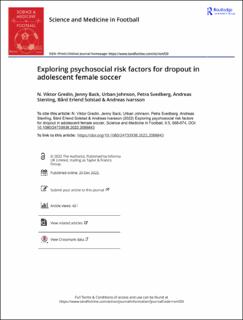| dc.contributor.author | Gredin, N. Viktor | |
| dc.contributor.author | Back, Jenny | |
| dc.contributor.author | Johnson, Urban | |
| dc.contributor.author | Svedberg, Petra | |
| dc.contributor.author | Stenling, Andreas | |
| dc.contributor.author | Solstad, Bård Erlend | |
| dc.contributor.author | Ivarsson, Andreas | |
| dc.date.accessioned | 2023-02-06T10:11:42Z | |
| dc.date.available | 2023-02-06T10:11:42Z | |
| dc.date.created | 2023-01-09T14:24:37Z | |
| dc.date.issued | 2022 | |
| dc.identifier.citation | Gredin, N. V., Back, J., Johnson, U., Svedberg, P., Stenling, A., Solstad, B. E. & Ivarsson, A. (2022). Exploring psychosocial risk factors for dropout in adolescent female soccer. Science and medicine in football, 6 (5), 668-674. doi: | en_US |
| dc.identifier.issn | 2473-3938 | |
| dc.identifier.uri | https://hdl.handle.net/11250/3048507 | |
| dc.description.abstract | Objectives We examined the manner in which age, participation in other sports, socioeconomic status, perceived sport competence, achievement goal orientations, and perceived motivational climate may interact to predict the risk of dropout among adolescent female soccer players. Methods Self-reported data from 519 female soccer players between 10 and 19 years of age (M = 13.41, SD = 1.77) were analysed using a person-centred approach to uncover the interactions among risk factors and their relative predictability of dropout. Results Perceived motivational climate was identified as the main predictor, where relatively lower levels of mastery climate were associated with a higher dropout tendency (absolute risk reduction [ARR] = 12.2% ±6.1% [95% CL]). If combined with relatively lower levels of mastery climate, then relatively lower levels of perceived sport competence were related to higher dropout risks (ARR = 16.5% ±9.5%), whereas, in combination with relatively higher levels of mastery climate, then relatively lower levels of ego-orientated achievement goals were associated with higher dropout rates (ARR = 10.8% ±12.6%) Conclusions Our findings afford novel insights into the interactions between, and the relative importance of, various risk factors for dropout in adolescent female soccer. This knowledge may be useful for soccer associations, clubs, and coaches when developing guidelines and strategies that aim to foster young females’ sustained participation in organised soccer. | en_US |
| dc.language.iso | eng | en_US |
| dc.publisher | Taylor & Francis | en_US |
| dc.rights | Attribution-NonCommercial-NoDerivatives 4.0 Internasjonal | * |
| dc.rights.uri | http://creativecommons.org/licenses/by-nc-nd/4.0/deed.no | * |
| dc.title | Exploring psychosocial risk factors for dropout in adolescent female soccer | en_US |
| dc.type | Peer reviewed | en_US |
| dc.type | Journal article | en_US |
| dc.description.version | publishedVersion | en_US |
| dc.rights.holder | © 2022 The Author(s) | en_US |
| dc.subject.nsi | VDP::Medisinske Fag: 700::Helsefag: 800 | en_US |
| dc.source.pagenumber | 668-674 | en_US |
| dc.source.volume | 6 | en_US |
| dc.source.journal | Science and medicine in football | en_US |
| dc.source.issue | 5 | en_US |
| dc.identifier.doi | 10.1080/24733938.2022.2088843 | |
| dc.identifier.cristin | 2103385 | |
| dc.description.localcode | Paid Open Access | en_US |
| cristin.qualitycode | 1 | |

